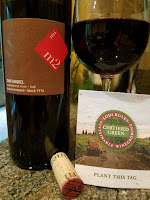Portuguese Port is rather redundant since thanks to the European Union Protected Designation of Origin guidelines most wine labeled as "Port" or "Porto" must be a fortified wine produced exclusively in the Douro region in the northern provinces of Portugal. This may not always be the case outside of Europe, but most countries are accepting the Portuguese Protected designation of origin.
Port wine is a classic style -- produced from grown and processed in the Douro demarcation and fortified with neutral grape spirit. There are over a hundred sanctioned grape varieties eligible for Port, but in general, expect the use of these five: Tinta Barroca, Tinta Cão, Tinta Roriz (Tempranillo), Touriga Francesa, and Touriga Nacional. There are also several categories of Port: White, Tawny, Ruby, Reserve, and Vintage. (See
The Wine Coach for specifics.) Ruby Ports are aged in large vats for two to three years before bottling whereas Vintage Ports are from a single harvest designated as an exceptional year and aged additional years in the bottle. The Reserve Port category was created by
Cockburn's (founded in 1815) to bridge these two styles where the wine is aged longer in large barrique casks. The goal was to create a wine similar in quality to the Vintage Port but drinkable early like the Ruby Port.
Symington Family Estates is a major player in Port as well as Douro Valley wine production, owning several brands such as
Cockburn's. I recently received samples from three of their brands described below.
Cockburn's Special Reserve Port ($18). This is apparently the world's most popular Reserve Port and is considered "The Original Reserve Port". The wine is produced from grapes harvested from their Quinta dos Canais vineyards in the Upper Douro and aged four to five years in oak casks. And this port is a great baseline for beginners. It is full bodied, with lush fruit and nut flavors, savory spices, a big mouthfeel, and a very healthy finish.
Warre's Warrior Port ($19). Warrior is the oldest continuously bottled Port brand (1750's) as Warrior has been branded on the casks of Warre’s finest Reserve Ports since the earliest days of the firm. The grapes are drawn from Quinta da Cavadinha and Quinta do Retiro, Warre’s best quintas in the
Pinhão and Rio Torto valleys that also produce Warre’s classic Vintage Ports. The wine is fruity and chewy, lot's of texture, with another long lingering finish. Apparently the higher altitudes and cooler climate lead to this ripe fruit character. For full bodied, yet fresh, easy drinking Port wine, start here.
Graham's Six Grapes Reserve Port ($24). "The distinctive depiction of the six bunches of grapes on the bottle originates from the marks long-used in the Graham's Lodge to classify the quality of the wines in the casks. The six-grapes symbol is Graham's age-old mark of quality, used to identify the very finest wines from the best vineyards, which were destined to make up the Vintage Port or Six Grapes lots". The grapes are sourced from five vineyards that are responsible for the brand's Vintage Ports, including Quinta dos Malvedos. The wine was the freshest of the trio, vibrant acids mingling with the dark blackberry fruit. The finish is long and clean. Well done.
 Mr. Oldman shared this sentiment at the Succotash Restaurant in Washington DC as Wines of Rías Baixas attempts to raise the profile of Albariño from the Galicia region of northwestern Spain. Last month they sponsored The Tastemakers Table, where "top sommeliers and wine experts teamed up to challenge palates showcasing the versatility of this Spanish white
wine". After attending the Succotash event I also received samples of the 2015 Lagar de Bouza ($18) and the 2015 Marques de Vizhoja Torre la Moreira ($17). Whereas the exact nature of Rías Baixas Albariño depends on which micro-climate the grape was grown, both of these wines share the common characteristics that make all Albariño an excellent and versatile wine: minerality and bright acids. Absolutely try these two wines.
Mr. Oldman shared this sentiment at the Succotash Restaurant in Washington DC as Wines of Rías Baixas attempts to raise the profile of Albariño from the Galicia region of northwestern Spain. Last month they sponsored The Tastemakers Table, where "top sommeliers and wine experts teamed up to challenge palates showcasing the versatility of this Spanish white
wine". After attending the Succotash event I also received samples of the 2015 Lagar de Bouza ($18) and the 2015 Marques de Vizhoja Torre la Moreira ($17). Whereas the exact nature of Rías Baixas Albariño depends on which micro-climate the grape was grown, both of these wines share the common characteristics that make all Albariño an excellent and versatile wine: minerality and bright acids. Absolutely try these two wines. 





